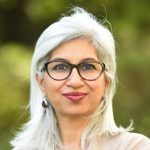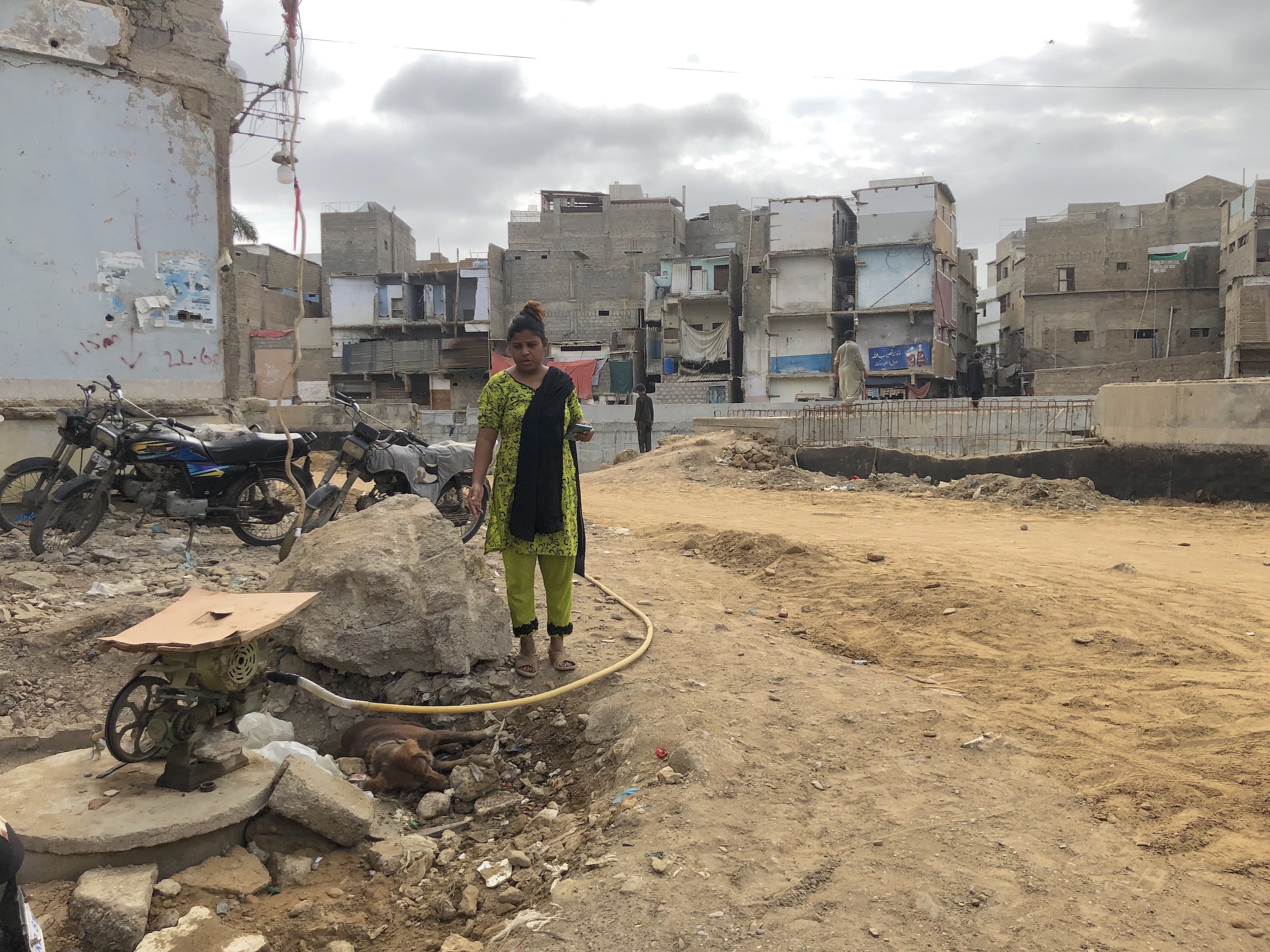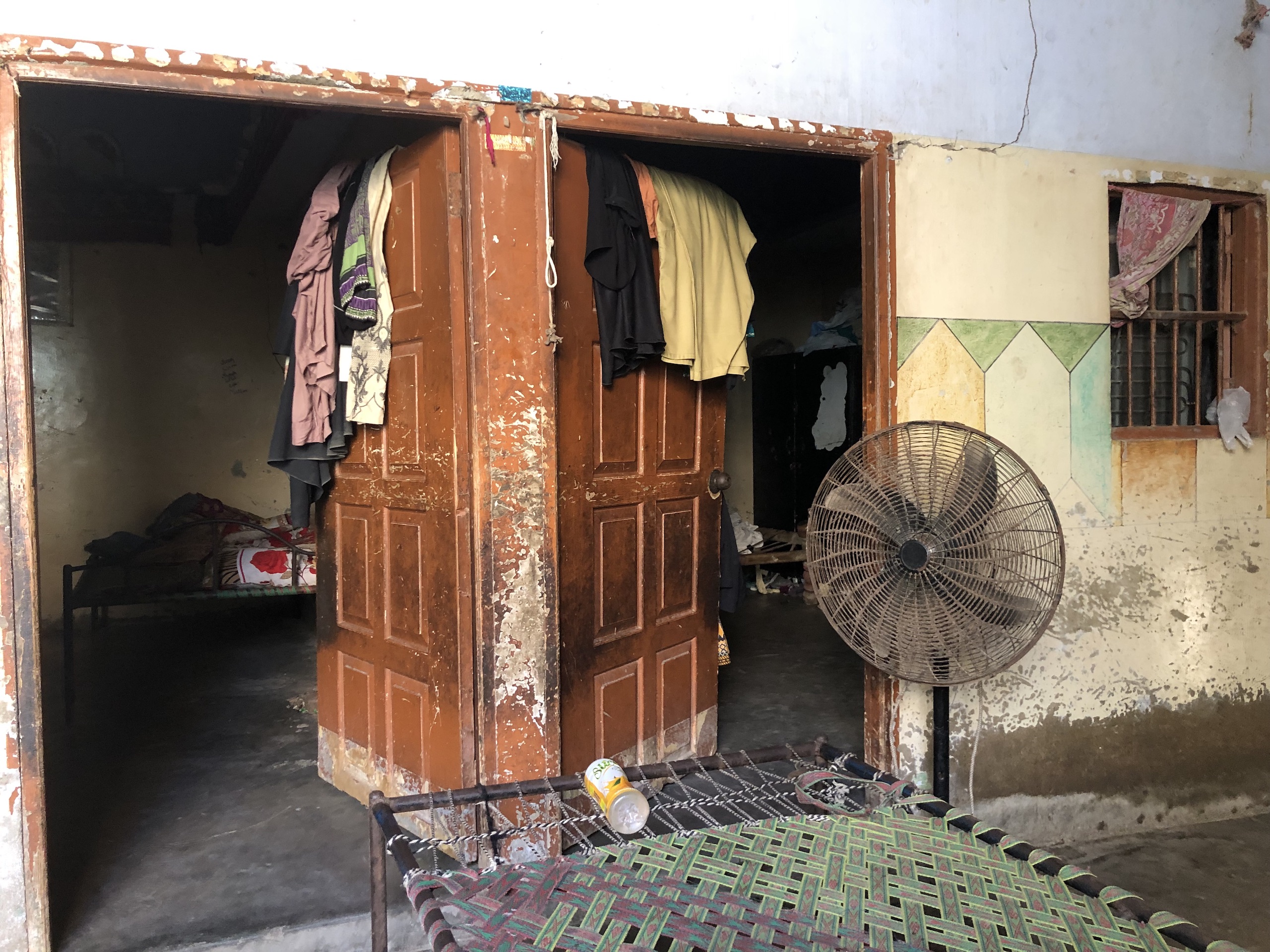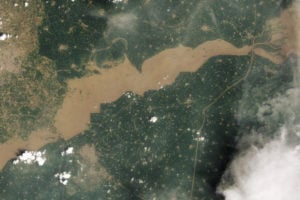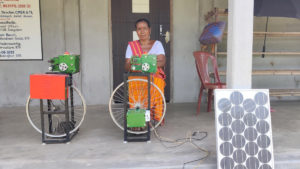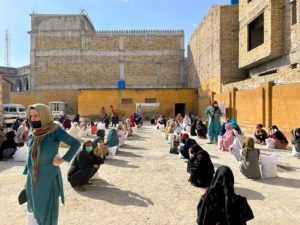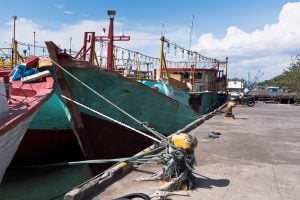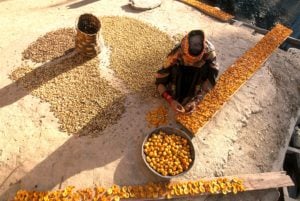Forty-year-old beautician, Sonia Arif, a mother of four, is struggling to make ends meet after her husband Arif had to shut his tailoring shop when they were unable to pay the monthly rent of 40,000 Pakistani rupees (USD 139). “I am sick of the yelling that has become a norm in my house for the past two years. The unbearable heat has added to my plight. In my next life, I want to be born as a man,” she says.
A resident of one of the most neglected areas in Karachi, Kausar Niazi Colony, along the Gujjar Nala stormwater drain, Sonia lost her home in 2021 in a huge demolition drive to remove encroaching structures that were throttling the natural waterway. She and her family had no option but to live in rented accommodation.
The clogged waterway was blamed for urban flooding in 2020, when large parts of Karachi were submerged after bouts of intense monsoon rainfall which Dr Sardar Sarfaraz, chief meteorologist at the Pakistan Meteorological Department, said was a “climate-related catastrophe” due to rise in global temperature. South Asia is particularly susceptible to the impacts of climate change, according to the Sixth Assessment Report by the Intergovernmental Panel on Climate Change (IPCC), with the region set to experience more extreme weather conditions in the coming decades, including heatwaves and flash floods, with serious consequences for vulnerable and marginalised populations.
The restricted role and freedom of women in Pakistan has added to their challenges in coping with climate-related extreme events. “Climate change impacts every element of their [women’s] lives: their economic security, marital relationships, and physical well-being,” finds research conducted by the Urban Institute in the slums of Delhi, Dhaka, Islamabad and Lahore.
Dr Arjumand Nizami, country director of Helvetas Swiss Intercooperation, a network of Swiss-based development organisations, agrees. “Climate change does not differentiate between genders; both women and men are just as likely to be affected by it. But due to economic, social, political and cultural inequalities, these unevenly felt challenges are getting harder during climate-induced catastrophes,” says Nizami, who is part of the organisation’s global climate change team.
Regressive rules add to women’s suffering in Pakistan
The anti-encroachment drive in Karachi could not have come at a worse time for many of the working class living in informal settlements. Reeling from a devastating flood last year, backbreaking inflation which stood at 27.4% in August, a depreciating currency (in July the Pakistani rupee fell 6.2%) and low foreign reserves – compounded by political instability – food, gas and fuel prices have shot up, pushing hundreds of thousands of people like Sonia and Arif deeper into the vortex of poverty.
Rakhi Matan, 35, lives in Karachi’s Shirin Jinnah Colony, and works as a domestic help in the adjoining neighbourhood of Clifton. “A woman’s work is never done,” she rues, saying the only time she got to herself was when she went to bed. During power cuts, men in her neighbourhood go out of their homes, but women must stay indoors. “We don’t have the luxury to go out; instead, we sit and cook in the dim light of the mobile phone, even if it gets stuffy and hot,” she says.
Few think about clothing and climate change, but it’s a lived reality for women here. “Men can be in their vests and shorts, even take off the vests; while we are forbidden to leave our homes; if we do, we have to drape ourselves in yards of cloth,” grumbles Rahat Shah, 37, a mother of 10 living in a three-room rented house in Gulshan-e-Sikandarabad, another informal settlement in Karachi. “Women observe purdah,” says Shah, who belongs to a Pashtun community which expects strict segregation of men and women.
“There is no need for them to go out, we do all the outside chores for them,” says her 22-year-old son, sitting next to Rahat. “It’s not even safe, and men look lewdly,” he adds. Out of work, the drug addict son believes that compared to his mother and four sisters, their father, a driver in the port, works the hardest.
“They just do the usual cleaning, cooking, washing,” he says dismissively, admitting that no male family members helps with the housework. “It’s women’s work,” he shrugs. Once he is out of earshot, his 16-year-old-sister, Shumaila, who is studying to become an Islamic teacher, whispers that she does not like wearing the burqa. “It’s cumbersome and stifling to walk around in it, I’d prefer covering my head with a dupatta, as it is airier, but I will never be allowed to go out like that,” she says.
“Patriarchy, misogyny, toxic masculinity and repressed sexuality in Pakistani males makes life extremely difficult to be a female in Pakistan, who bear the brunt everywhere, be it urban, semi-urban, rural, mountainous areas, villages or cities,” says Dr Murad Khan, professor of psychiatry at Aga Khan University Hospital’s Brain and Mind Institute. “Nothing has changed — expectations from women, their performance, or the attitude of men,” he says.
“Unending house chores and elderly/childcare is compounded by a lack of safety in public spaces which keeps women indoors,” says Dr Anwar. Climate-related extreme weather makes this worse.
Coping with extreme weather events
Recent research by the Karachi Urban Lab (KUL) found that over the past 60 years, Karachi’s average daytime temperature has risen by 1.6 degrees Celsius, and nighttime temperatures by 2.4 degrees Celsius. Dr Anwar connects the city’s expansion, compaction, and densification to this rise in temperature, intersecting with global warming.
Rahat says this year was hotter than ever, and with a long power outage and huge water shortage, the situation did not get better. “We need five canisters of 20 litres [each costing 35 rupees] a day for my family of 12,” she says, which they use for washing clothes and utensils, and bathing. For work, she cooks for a doctor, earning barely PKR 12,000 (USD 42) a month.
In the congested informal settlements where all these women live, houses are so close to each other that “you can literally hear each and every conversation of your neighbour,” according to Sonia, while too many live in poorly ventilated homes. “Our homes turn into infernos in summer,” says Sonia.
The lack of a proper sewerage system spreads water-borne diseases, especially among children. The IPCC’s Climate Change 2023 Synthesis Report says that human mortality and morbidity as well as climate-related food-borne, water-borne and vector-borne diseases have increased due to increased heat.
“It’s either the fever, or stomach infection,” says 29-year-old Aasia Kamran, a mother of children aged 6 and 4 years and a 9-month-old baby, living in a one-room quarter in Nayabad, in Lyari. Working as a part-time house help but now on a break to take care of the baby, she says: “When they [the children] get sick, it means taking off from work for days causing additional stress as our employers get annoyed; fathers never take off from work or care for the children.”
Maria Yaqoob, a 23-year-old student living in the same neighbourhood as Sonia, insists the role of a woman in a village is easier than in the shanty towns of Karachi. Not only do village women have open spaces, points out Maria, they are self-sufficient. “They know how to make fuel from dung, carry firewood and water and are adept at running their homes. On the other hand, our lives come to a standstill if we don’t have conveniences like water, gas and electricity,” she says.
For the past two years, both Rakhi and Rahat have been cutting wood from the nearby creek for cooking “like the village women” when “we run out of gas in the cylinder”. This new task has added to their workload, says Rakhi. “It takes me an hour to collect the wood and it will last us just two or three days.” Although it burns her eyes and she uses plastic bags to ignite the fire, knowing well these give out toxic fumes, “with gas prices getting steeper by the day, I have little choice,” she says.
We don’t want men to speak on our behalf – we have a voice and want to be heardMaria Yaqoob, student
“The urban women living in informal settlements do not have the skill sets to manage their daily chores, without modern conveniences,” admits Nizami, adding that village women are as much exposed to climate change as their urban counterparts.
Having worked with women in informal settlements in both cities and villages for almost three decades, she says both carry a huge, but different, workload. “But, for both, their work remains invisible and unrecognised,” she says.
While village women are closer to natural resources, they work for free on their family farm. In urban settings, mismanagement, thefts and leakages in utilities and a weak governance system have been exacerbating the impact of climate change on women. “Coping with climate-induced heatwaves and long power outages and water shortages (both manmade) get amplified,” she says, adding: “These things are a big reason for stress among women, who are not only working at home but also employed outside.”
Adds Rahat: “Women have to make sure there is enough water, that the food is cooked, and the house is spotless; how they get all of it done without water and electricity is not a man’s problem.”
Zoha Alvi, an organiser of the Aurat March, an annual socio-political demonstration in Pakistani cities, says political parties and public office holders should be made accountable for not carrying out their responsibilities. “They should look at the issue of climate change through the lens of intersectionality that needs to be acknowledged and understood as it adds more layers to this important conversation. All the issues will ultimately affect us severely.”
Mental health not a priority
The 2023 IPCC synthesis report indicated that “mental health challenges” are associated with increasing temperatures, trauma from extreme weather events, and loss of livelihoods and culture. “With increasing social, environmental and manmade problems, the stress on women has increased,” says Dr Khan. But there is little evidence, he points out, to say conclusively whether the mental health of rural women is worse than their urban counterparts.
Both mental health and climate change are generally low on the government’s list of priorities. “When this happens, then the connection between the two cannot be made by governments, either provincial or national,” says Dr Khan, adding that governments are engrossed in tiding over other crises – economic, power, political, and security.
Dr Sajjad Ahmad, a public health specialist at Koohi Goth Women’s Hospital, says that the floods in 2010 and 2022 brought to the fore how climate-induced catastrophes exacerbate women’s problems when broken-down health centres are washed away. “The vicious cycle of poverty, lack of education, poor healthcare system and climate change are interlinked, and each exacerbates the other. You cannot take out women’s health and look at it through one lens alone. Poverty combined with illiteracy amplifies health issues for women, especially those who are pregnant.”
Designing cities with climate change in mind
Marvi Mazhar, an architect and climate activist, says it is critical to think of ethical land distribution, improving housing affordability and making Karachi more livable and breathable. “Karachi has been a power project. It’s been developed in isolation, on land-to-land infrastructure rather than zonal, neighbourhood or in a cluster form,” she says.
Yasmeen Lari, 82, Pakistan’s first woman architect, heads the Heritage Foundation of Pakistan and has been designing bamboo houses for people living on the front lines of climate change.
Her design philosophy of “zero emissions and zero waste” ensures that the “poor are seen as partners, keeping women in the lead”. Having worked with women for years in rural areas, she says “the same principles, but with a bit of modification, can be applied in informal settlements in Karachi”.
“Our policies, programmes and projects keep little margin for climate-related events,” agrees Dr Noman Ahmed, who heads the Architecture & Management Sciences department at the NED University of Engineering and Technology in Karachi. Referring to the Karachi Development Plan 1974-85, as well as several scientific studies thereafter, he says the administration had been cautioned to keep the periphery of Karachi as pastoral land, to serve as the city’s food basket.
“Sadly, the same territory that was to provide the ecological balance the city badly requires today, has been transformed into real estate,” says Dr Ahmed, adding that land formations such as natural hills, hillocks and water bodies have either been levelled or reclaimed for commercial development.
Mazhar calls for a “democratic demarcation”, where the city’s residents are given the “authority to be part of master planning and design development”. Admittedly a radical notion, this green environmental plan requires “rethinking development”.
Dr Ahmed says cultural and lifestyle interventions are needed so that women in informal settlements can access public spaces and parks on a regular basis. “The concept and application of women and children-only bagh [park] is also a good idea,” he suggests, adding this had found resonance in some planned neighbourhoods in Karachi.
Karachi needs a domestic design system, where economics and maintenance go hand in hand, says Mazhar. This means opting out of the race to be the ‘biggest city’, she says, and giving women greater representation at the table when decisions about the city are being made, so they can have a say on effective solutions.
But until that happens, Dr Khan suggests, the women of a neighbourhood can get together, exchange notes, support each other, organise and protest. “Their collective voice can make a difference,” he says.
Maria recalls how protests against demolitions in Kausar Niazi and Tayyababad colonies united the women, who experienced the immense difficulties of being homeless at a time when the city faced extreme weather events. “For the first time, we realised there is strength in numbers and we voiced our protest more vociferously,” she says. And “a few hours spent in a lockup” for being part of a peaceful march gave a huge boost to her confidence, she says. “We don’t want men to speak on our behalf – we have a voice and want to be heard.”
Although they failed in stopping the bulldozers from knocking down their homes, “the feeling that we were together during this tragedy was comforting,” says Maria.
The report ‘Climate Equity: Women as agents of change’ stresses the need for gender-sensitive frameworks for policies relating to climate change mitigation and adaptation. Pakistan’s overhauled climate change policies have “called for a reappraisal of women’s vulnerability and gender-sensitive objectives to address women’s differentiated burdens in climate stress”, the report says.
Dr Zulfiqar Bhutta, founding director of the Institute for Global Health and Development and the Centre of Excellence in Women and Child Health at Aga Khan University, has been researching informal settlements in Karachi and rural districts of Sindh for over two decades, primarily focusing on women and children’s health and nutrition. According to him, many of the social disadvantages women face are compounded by misplaced social norms, restricted mobility and ingrained gender inequalities. “These can also impact the ability of rural women to adjust their lifestyle during peak summer months. For many of these issues, there is no short-term solution, and bringing about a change in mindsets is challenging to say the least. However, we must raise awareness about the impacts of climate change and how to adapt to extreme heat, which are now existential realities,” says Dr Bhutta.
Pakistan’s National Adaptation Plan, launched in July this year, features gender and youth as cross-cutting themes, highlighting the integration of vulnerable groups in key decision-making bodies related to climate change such as climate councils, environmental agencies, and advisory committees.
Adaptation needs to be taken out of its stepchild slot both in Pakistan and in global policy-making, Pakistan’s former climate change and environmental coordination minister Sherry Rehman said in a recent interview with The Third Pole. “It needs active financing and capacity resourcing as a national emergency if the country is to survive growing heat and related shocks.”
For a country grappling with extreme weather patterns, it is important to focus on the most vulnerable populations, and to make women’s voices heard.
This story was first published in the online journal Question of Cities and was supported by a fellowship from Question of Cities and Climate Action Network South Asia.

